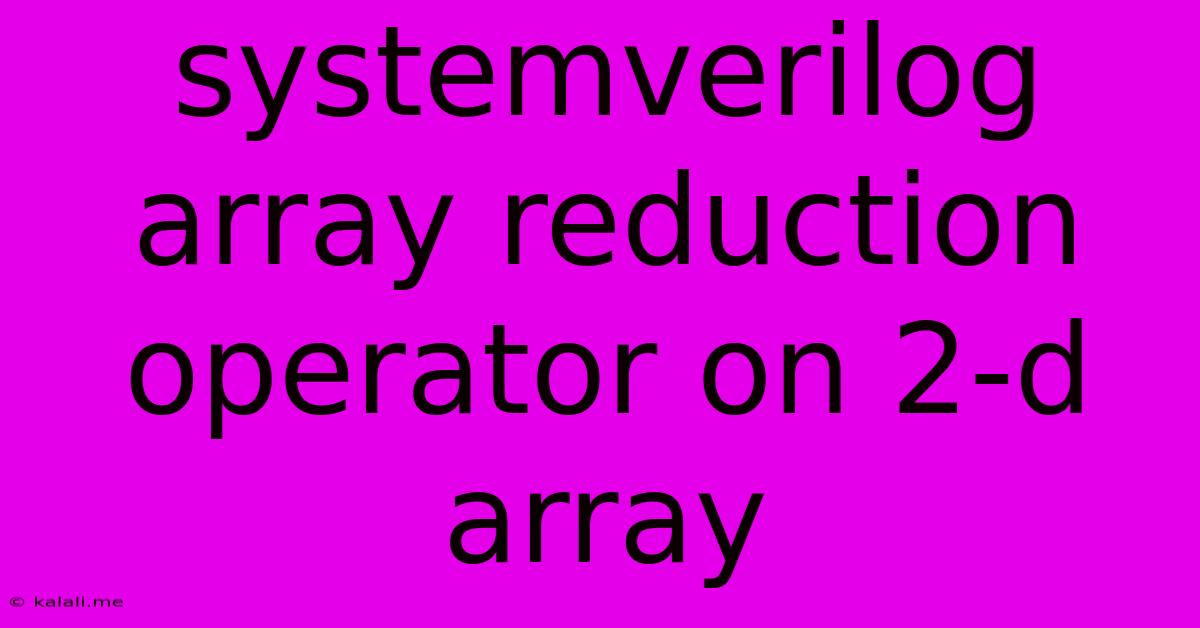Systemverilog Array Reduction Operator On 2-d Array
Kalali
May 30, 2025 · 3 min read

Table of Contents
SystemVerilog Array Reduction Operators on 2D Arrays: A Comprehensive Guide
SystemVerilog offers powerful array reduction operators that significantly simplify code when dealing with array manipulations. These operators allow you to perform operations like summing, ANDing, or ORing all elements of an array in a single, concise statement. While often demonstrated with 1D arrays, their application to 2D arrays is equally valuable and sometimes more challenging to understand. This article provides a detailed explanation of how to effectively use array reduction operators on 2D arrays in SystemVerilog.
This guide will cover the practical application and intricacies of using reduction operators on 2D arrays within SystemVerilog, enabling efficient and readable code for verification and design. We will explore different scenarios, handle potential pitfalls, and provide clear examples to illustrate their usage.
Understanding SystemVerilog Array Reduction Operators
Before diving into 2D arrays, let's briefly review the basic reduction operators. These operators take an array as input and return a single value that represents the result of the specified operation on all array elements. Common reduction operators include:
+:Addition (summation)*:Multiplication&:Logical AND|:Logical OR^:Logical XOR
Applying Reduction Operators to 2D Arrays
Applying reduction operators to a 2D array requires a slightly different approach. You cannot directly apply a single reduction operator to the entire 2D array. Instead, you need to apply the reduction operator iteratively, typically using a loop. Here's how:
Method 1: Nested Loops
This is the most straightforward method. You use nested loops to iterate through each row and then each column of the 2D array, accumulating the result using the chosen reduction operator.
module reduction_example;
int array_2d [3][4];
int sum;
initial begin
// Initialize the 2D array
array_2d = '{ '{1, 2, 3, 4}, '{5, 6, 7, 8}, '{9, 10, 11, 12} };
sum = 0;
for (int i = 0; i < 3; i++) begin
for (int j = 0; j < 4; j++) begin
sum += array_2d[i][j];
end
end
$display("Sum of all elements: %0d", sum); // Output: Sum of all elements: 78
end
endmodule
Method 2: Using for loop with array reduction within the loop:
This method leverages the reduction operator on each row first, then sums the row totals. This improves readability compared to fully nested loops, especially for larger arrays.
module reduction_example_improved;
int array_2d [3][4];
int row_sums[3];
int total_sum;
initial begin
array_2d = '{ '{1, 2, 3, 4}, '{5, 6, 7, 8}, '{9, 10, 11, 12} };
for (int i = 0; i < 3; i++) begin
row_sums[i] = array_2d[i] +:; // Reduction operator on each row
end
total_sum = row_sums +:; // Reduction operator on the array of row sums
$display("Sum of all elements: %0d", total_sum); // Output: Sum of all elements: 78
end
endmodule
Handling Different Data Types
The reduction operators work seamlessly with various data types, including int, bit, logic, and others. Remember to choose the appropriate operator for your data type and intended operation. For example, using &: on bit or logic arrays performs a bitwise AND operation.
Advanced Scenarios and Considerations
- Empty Arrays: Handle potential empty arrays gracefully. Check the array dimensions before performing the reduction operation to avoid errors.
- Large Arrays: For extremely large arrays, consider using more advanced techniques like parallel processing to optimize performance.
- Specific Row/Column Operations: If you only need the sum of a specific row or column, you can modify the loop to iterate only over that specific row or column.
Conclusion
SystemVerilog's array reduction operators, even when used iteratively, offer a significant advantage in terms of code clarity and conciseness when working with 2D arrays. While a direct single-operator reduction on a 2D array isn't supported, the methods described above provide efficient and readable solutions. Understanding these techniques enables you to write more efficient and maintainable SystemVerilog code for your verification and design tasks. Remember to choose the method that best suits your coding style and the complexity of your array manipulations.
Latest Posts
Latest Posts
-
Check If Service Is Running Linux
May 31, 2025
-
Socrates Dar A Luz A Ideas
May 31, 2025
-
Ceiling Fan Pull Chain Switch Replacement
May 31, 2025
-
Yahoo Finance Search By Ticker Doesnt Show The Result
May 31, 2025
-
Movies With Teacher And Student Relationship
May 31, 2025
Related Post
Thank you for visiting our website which covers about Systemverilog Array Reduction Operator On 2-d Array . We hope the information provided has been useful to you. Feel free to contact us if you have any questions or need further assistance. See you next time and don't miss to bookmark.